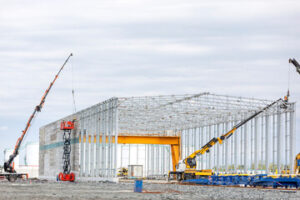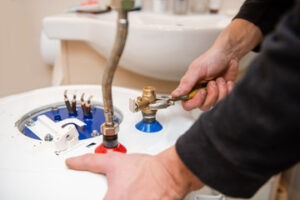A roof is an important part of a house or building that protects against rain, snow, sun, wind, and temperature extremes. It can be constructed in a variety of forms, depending on structural or aesthetic considerations.
The frame of a roof is constructed with rafters or prefabricated trusses. Sheathing is typically made of plywood or oriented strand board. The peak of a sloped roof is called a ridge; the bottom edge is known as an eave. Contact Erie Roofing now!

Roofing has evolved over the millennia to meet the changing needs and aesthetics of societies. The journey of roofing is a testament to human ingenuity and adaptability. It protects against the elements, including rain, snow, sunlight, wind and extreme temperatures. It can also serve as a decorative element that enhances the overall look of a building.
Early humans relied on whatever materials were available in their natural environments to shelter them from the weather. Some of the earliest roofing materials were animal skins, branches, sticks and clay.
In tropical areas, palm fronds were popular choices. People also used reeds and dried grass to create roofs. One of the earliest roofing techniques, known as thatching, involved layering dried vegetation like straw or reeds over a framework of mud and branches to form a solid cover. However, it was flammable and required frequent maintenance.
As civilizations advanced, more durable and fire-resistant roofing materials were introduced. One of the most significant advances was tile roofing, which was first developed by the Greeks and Romans. Tile roofing was created by firing clay in kilns, which gave it durability and strength. The tiles interlocked with each other to offer additional structural support, which made them more resistant to water.
In the 18th century, people started treating wood shingles to give them different colors and aesthetic appeal. By the 20th century, people began using tin and aluminum to cover buildings. Today, roofing is an integral part of many home and business structures. It’s important to choose a roofing system that’s both functional and appealing, so you can enjoy the protection it provides without sacrificing your sense of style. A professional can help you find the right roof for your home or business.
Materials
Roofing contractors need to work with a variety of materials. These include roofing shingles, sheathing and roof membranes, among others. The type of roofing materials used will impact the cost and look of your home, as well as how long it will last and how it will protect the environment. There are also various roofing styles to choose from, and each style comes with pros and cons.
Asphalt shingles are the most common roofing material, with a lifespan of 20 to 30 years. These are available in a wide range of colors and designs to match any style. They are lightweight and inexpensive, making them a popular choice for homeowners.
Wood shingle or shake roofs are more expensive, but they offer a natural, rustic look that is hard to match with any other roofing material. Shingles are sawmilled into a precise shape, while shakes are split to produce thicker wedges with a rough texture. In relatively dry climates, a shake or shingle roof can last 60 years or more.
Clay tiles date back 5,000 years to glazed earthenware rooftops in China. These tiles lay in an overlapping pattern and can be left unglazed for a natural look, or they can be glazed to give a more colorful appearance. They are highly durable and water-resistant, as well as fire resistant. This makes them an excellent roofing option for areas prone to wildfire danger.
Standing seam metal roofs are made of large panels that run vertically along a roof slope. They are highly durable and fire-resistant, but they are expensive. This makes them more suitable for commercial buildings than for residential use.
Corrugated galvanized iron was the dominant roof material of 20th century Australia, but it is now being replaced with newer materials that are more attractive and longer-lasting. These are available in a variety of colors and finishes, including aluminum, zinc and copper.
Membrane roofing is an effective water protection option for flat or low-slope roof areas, and it can be added to other roofing materials like shingles or concrete. This is a durable roofing choice that can be installed in hot or cold climates and resists UV rays and chemicals. A quality membrane can be topped with a layer of mineral-surfaced leak barrier for extra protection from the elements.
Installation
The roof is an important part of any building structure. It serves to shield a house’s occupants from diverse weather elements like rain, snow, cruel UV rays, and strong winds. It also functions to prevent water leaks and moisture damage.
A roofing contractor will start by assessing your existing roof and determining what needs to be done to it. Next, you will need to select the roofing material that meets your needs. There are many options to consider, including dimensional shingles for added curb appeal, three-tab shingles for cost effectiveness, wood shakes for a natural look, metal sheeting for durability, and clay tiles for ultimate longevity.
Once the new materials are chosen, your roofing company will start by laying down the underlayment. Then, your roofer will begin installing the shingle rows. He will overlap each row by about six inches, and he will nail them down in a pattern that includes close nails at the edge and those that are spread out farther toward the center of the shingle. He will continue the overlapping and nailing process until the ridge of the roof is reached. He will then install flashing around the eaves and in roof valleys, as well as along chimneys and wood stove pipes, and he will apply roofing cement to all seams and nail holes.
Maintenance
A home’s roof serves a critical function in protecting the interior of a living space from diverse climate factors. Whether shielding occupants from harsh UV rays or preventing water leaks, a well-constructed roof is essential for comfortable and safe living. However, it is possible for a roof to deteriorate over time due to neglect or natural wear and tear. This is why roofing requires regular maintenance and inspections to catch small problems before they escalate.
During a typical roof inspection, it is important to look for areas of deterioration, cracking, thinning, openings or crazing. This will help nip issues in the bud before they become major problems, which can cost thousands of dollars in repairs or re-roofing costs. Additionally, a roof should be checked to ensure the flashing is tight and free from leaks. This is especially important around penetrations, such as chimneys, vents, skylights and exhaust fans.
It is also a good idea to make sure gutters are free of blockages and that they are draining properly. This will allow for proper flow of rainwater and prevent overflow and ice damming in winter.
Finally, it is a good idea to trim any tree branches that hang over the roof. This will help to protect the shingles from debris during high winds and heavy storms and can also reduce moss growth. Regularly checking the growth of tree limbs will help you know when they are getting long and should be trimmed. Keeping trees properly trimmed will also prevent tumbling limbs during a storm, which can damage the roof.








